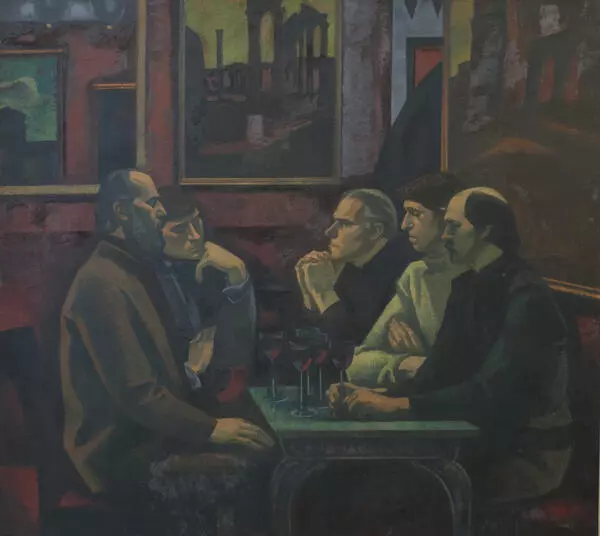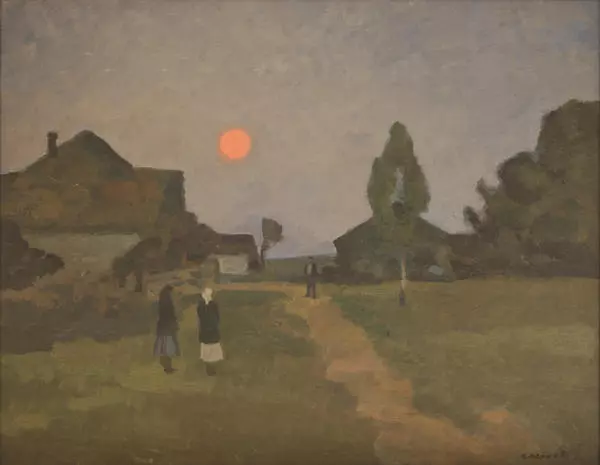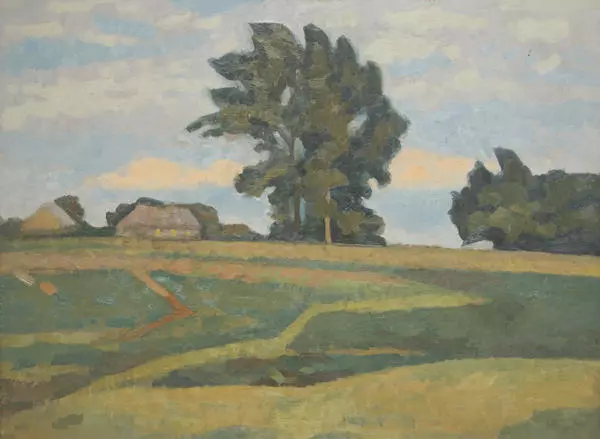The painting “Fall. The Early Month” by artist Viktor Ivanov is a simple autumn landscape with a large sprawling tree and a house surrounded by a fence. Above the house, one can see a waxing moon. The painting is completely devoid of movement and dynamism. Because of this simple and clear artistic solution, it seems as if the time has stopped.
Viktor Ivanov dedicated his work to the Soviet village of the war and postwar years, which he loved for its genuineness and simple beauty. He adhered to the “Severe style”, and his works are distinguished by monumental images, expressive compositions and peculiar color schemes.
The “Severe style” was a movement within the Soviet realism, characteristic of the turn of the 1950s. Masters of this style were inspired by the works of Soviet artists of pre-Stalin era. Their paintings were characterized by generalized and laconic images, large planes of color, and straight lines. The main subject of the Severe style was “the heroism of day-to-day labor” and historic events, but many masters, including Ivanov, often chose “low” genres from an academic point of view — portrait, landscape and still life.
Viktor Ivanov was born in 1924 in Moscow. He studied at the Art Studio of the Central House of Pioneers until 1939; from 1939 to 1944, he attended the Surikov Moscow State Academic Art Institute and graduated from the Institute in 1950.
In 1950, Ivanov began to actively participate in Moscow, republican and national exhibitions. In 1950–1952 he taught at the art school from which he himself had graduated.
Ivanov’s creative principles were formed during the “Thaw” period. This was the end of the Stalinist era and a turn in the political life of the country — the war and the years of repression ended. By the 1960s, the euphoria of freedom gave way to the romance of daily life. The communism building became the main idea of the time, and labor was the main theme of art. A cult of harsh, with no illusions, uncompromising and merciless truth about people and their history, about nature, appeared in art.
Ivanov is considered one of the founders of the “Severe style”, but the artist himself prefers to be called a “Sixtier”.
Viktor Ivanov dedicated his work to the Soviet village of the war and postwar years, which he loved for its genuineness and simple beauty. He adhered to the “Severe style”, and his works are distinguished by monumental images, expressive compositions and peculiar color schemes.
The “Severe style” was a movement within the Soviet realism, characteristic of the turn of the 1950s. Masters of this style were inspired by the works of Soviet artists of pre-Stalin era. Their paintings were characterized by generalized and laconic images, large planes of color, and straight lines. The main subject of the Severe style was “the heroism of day-to-day labor” and historic events, but many masters, including Ivanov, often chose “low” genres from an academic point of view — portrait, landscape and still life.
Viktor Ivanov was born in 1924 in Moscow. He studied at the Art Studio of the Central House of Pioneers until 1939; from 1939 to 1944, he attended the Surikov Moscow State Academic Art Institute and graduated from the Institute in 1950.
In 1950, Ivanov began to actively participate in Moscow, republican and national exhibitions. In 1950–1952 he taught at the art school from which he himself had graduated.
Ivanov’s creative principles were formed during the “Thaw” period. This was the end of the Stalinist era and a turn in the political life of the country — the war and the years of repression ended. By the 1960s, the euphoria of freedom gave way to the romance of daily life. The communism building became the main idea of the time, and labor was the main theme of art. A cult of harsh, with no illusions, uncompromising and merciless truth about people and their history, about nature, appeared in art.
Ivanov is considered one of the founders of the “Severe style”, but the artist himself prefers to be called a “Sixtier”.







